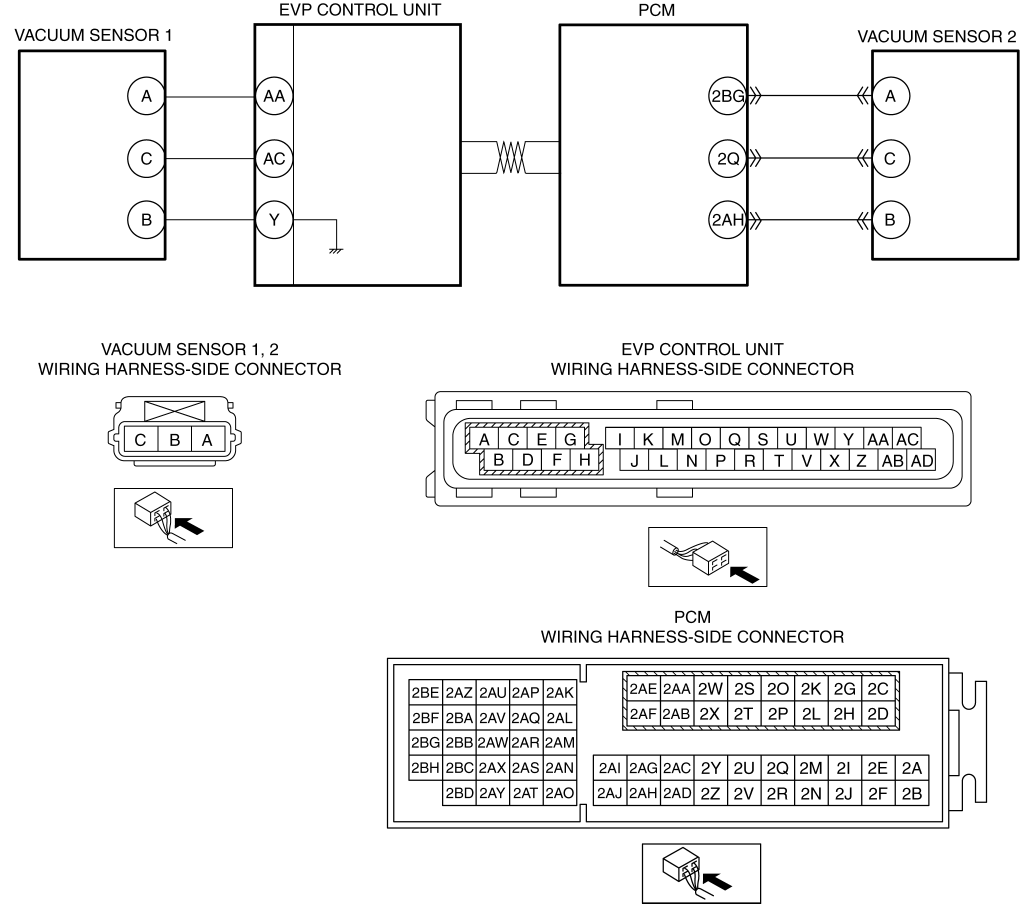DTC C101A:00 [EVP CONTROL UNIT]
| DTC |
C101A:00 |
Vacuum sensor 1/ Vacuum sensor 2 correlation problem |
| DETECTION CONDITION |
|
|
| FAIL-SAFE FUNCTION |
|
|
| POSSIBLE CAUSE |
|
|
Diagnostic Procedure
| Step |
Inspection |
Action |
|
| 1 |
RECORD SNAPSHOT DATA AND DIAGNOSTIC MONITORING TEST RESULTS TO UTILIZE WITH REPEATABILITY VERIFICATION NOTE:
|
— |
Go to the next step. |
| 2 |
VERIFY IF DIAGNOSTIC RESULT IS AFFECTED BY OTHER RELATED DTCs OCCURRING
|
Yes |
Go to the applicable DTC inspection. |
| No |
Go to the next step. |
||
| 3 |
DETERMINE WHETHER MALFUNCTION IS PAST OR PRESENT
|
Yes |
Go to Step 8. |
| No |
Go to the next step. |
||
| 4 |
VERIFY DTC REPEATABILITY
|
Yes |
|
| No |
Go to the next step. |
||
| 5 |
INSPECT VACUUM SENSOR 1 AND VACUUM SENSOR 2 CIRCUITS
|
Yes |
Go to the next step. |
| No |
Repair or replace the malfunctioning part, then go to Step12. |
||
| 6 |
DRIVE VEHICLE THEN VERIFY DTC REPEATABILITY BASED ON SERVICE QUESTIONING RESULTS AND SNAP SHOT DATA
|
Yes |
Go to Step 8. |
| No |
Go to the next step. |
||
| 7 |
DRIVE VEHICLE THEN VERIFY DTC REPEATABILITY BASED ON SERVICE QUESTIONING RESULTS AND SNAP SHOT DATA
|
Yes |
Replace the EVP control unit, then go to Step 13. |
| No |
DTC troubleshooting completed. Explain to the customer that there are no malfunctions with the vehicle based on the contents of the servicing. |
||
| 8 |
INSPECT VACUUM SENSOR 1 CIRCUIT
|
Yes |
Go to the next step. |
| No |
Repair or replace the malfunctioning part, then go to Step 12. |
||
| 9 |
INSPECT VACUUM SENSOR 1
|
Yes |
Go to the next step. |
| No |
Replace the power brake unit, then go to Step 12. |
||
| 10 |
INSPECT VACUUM SENSOR 2 CIRCUIT
|
Yes |
Go to the next step. |
| No |
Repair or replace the malfunctioning part, then go to Step 12. |
||
| 11 |
INSPECT VACUUM SENSOR 2
|
Yes |
Go to the next step. |
| No |
Replace the power brake unit, then go to the next step. |
||
| 12 |
VERIFY DTC TROUBLESHOOTING COMPLETED
|
Yes |
Repeat the inspection from Step1. If the malfunction recurs, replace the EVP control unit, then go to the next step. |
| No |
Go to the next step. |
||
| 13 |
VERIFY NO DTC IS PRESENT
|
Yes |
Go to the applicable DTC inspection. (See DTC TABLE [EVP CONTROL UNIT].) |
| No |
DTC troubleshooting completed. |
||
